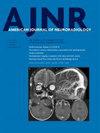DSA Quantitative Analysis and Predictive Modeling of Obliteration in Cerebral AVM following Stereotactic Radiosurgery.
IF 3.7
3区 医学
Q2 CLINICAL NEUROLOGY
引用次数: 0
Abstract
BACKGROUND AND PURPOSE Stereotactic radiosurgery is a key treatment modality for cerebral AVMs, particularly for small lesions and those located in eloquent brain regions. Predicting obliteration remains challenging due to evolving treatment paradigms and complex AVM presentations. With digital subtraction angiography (DSA) being the gold standard for outcome evaluation, radiomic approaches offer potential for more objective and detailed analysis. We aimed to develop machine learning modeling using DSA quantitative features for post-SRS obliteration prediction. MATERIALS AND METHODS A prospective registry of patients with cerebral AVMs was screened to include patients with digital prestereotactic radiosurgery DSA. Anterior-posterior and lateral views were retrieved and manually segmented. Quantitative features were computed from the lesion ROI. Following feature selection, machine learning models were developed to predict unsuccessful 2-year total obliteration using processed radiomics features in comparison with clinical and radiosurgical features. When we evaluated through area under the receiver operating characteristic curve (AUROC), accuracy, area under the precision-recall curve F1, recall, and precision, the best performing model predictions on the test set were interpreted using the Shapley additive explanations approach. RESULTS DSA images of 100 included patients were retrieved and analyzed. The best-performing clinical radiosurgical model was a gradient boosting classifier with an AUROC of 68% and a recall of 67%. When we used radiomics variables as input, the AdaBoost classifier had the best evaluation metrics with an AUROC of 79% and a recall of 75%. The most important clinico-radiosurgical features, ranked by model contribution, were lesion volume, patient age, treatment dose rate, the presence of seizure at presentation, and prior resection. The most important ranked radiomics features were the following: gray-level size zone matrix, gray-level nonuniformity, kurtosis, sphericity, skewness, and gray-level dependence matrix dependence nonuniformity. CONCLUSIONS The combination of radiomics with machine learning is a promising approach for predicting cerebral AVM obliteration status following stereotactic radiosurgery. DSA could enhance prognostication of stereotactic radiosurgery-treated AVMs due to its high spatial resolution. Model interpretation is essential for building transparent models and establishing clinically valid radiomic signatures.立体定向放射手术后脑动静脉畸形闭塞的 DSA 定量分析和预测模型。
背景和目的立体定向放射外科手术是治疗脑动静脉畸形的一种主要方法,尤其适用于小病灶和位于脑功能区的病灶。由于治疗范例的不断发展和反车辆瘤的复杂表现,预测瘤体消失仍具有挑战性。数字减影血管造影术(DSA)是结果评估的黄金标准,而放射学方法则为更客观、更详细的分析提供了可能。我们的目标是利用 DSA 定量特征建立机器学习模型,用于 SRS 后的湮灭预测。材料和方法筛选了脑动静脉畸形患者的前瞻性登记,纳入了接受数字前定向放射手术 DSA 的患者。对前后位和侧位切面进行检索和人工分割。根据病变 ROI 计算定量特征。在特征选择之后,我们开发了机器学习模型,利用处理过的放射组学特征与临床和放射外科特征进行比较,预测两年内不成功的全腔阻塞。我们通过接收者操作特征曲线下面积(AUROC)、准确度、精确度-召回曲线下面积F1、召回率和精确度进行评估,使用夏普利加法解释方法对测试集上表现最佳的模型预测进行解释。表现最好的临床放射外科模型是梯度提升分类器,AUROC 为 68%,召回率为 67%。当我们使用放射组学变量作为输入时,AdaBoost 分类器的评估指标最好,AUROC 为 79%,召回率为 75%。按模型贡献率排序,最重要的临床放射外科特征是病灶体积、患者年龄、治疗剂量率、发病时是否有癫痫发作以及之前是否进行过切除术。最重要的放射组学特征排序如下:灰度级大小区矩阵、灰度级不均匀性、峰度、球度、偏度和灰度级依赖性矩阵依赖性不均匀性。由于 DSA 的空间分辨率高,它可以提高立体定向放射手术治疗后 AVM 的预后。模型解释对于建立透明模型和建立临床有效的放射学特征至关重要。
本文章由计算机程序翻译,如有差异,请以英文原文为准。
求助全文
约1分钟内获得全文
求助全文
来源期刊
CiteScore
7.10
自引率
5.70%
发文量
506
审稿时长
2 months
期刊介绍:
The mission of AJNR is to further knowledge in all aspects of neuroimaging, head and neck imaging, and spine imaging for neuroradiologists, radiologists, trainees, scientists, and associated professionals through print and/or electronic publication of quality peer-reviewed articles that lead to the highest standards in patient care, research, and education and to promote discussion of these and other issues through its electronic activities.

 求助内容:
求助内容: 应助结果提醒方式:
应助结果提醒方式:


